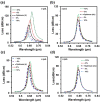Plasmonic Micro-Channel Assisted Photonic Crystal Fiber Based Highly Sensitive Sensor for Multi-Analyte Detection
- PMID: 35564153
- PMCID: PMC9099450
- DOI: 10.3390/nano12091444
Plasmonic Micro-Channel Assisted Photonic Crystal Fiber Based Highly Sensitive Sensor for Multi-Analyte Detection
Abstract
A dual-channel propagation controlled photonic crystal fiber (PCF)-based plasmonic sensor was presented to detect multiple analytes simultaneously. Plasmonic micro-channels were placed on the outer surface of the PCF, which facilitates an easy sensing mechanism. The sensor was numerically investigated by the finite element method (FEM) with the perfectly matched layer (PML) boundary conditions. The proposed sensor performances were analyzed based on optimized sensor parameters, such as confinement loss, resonance coupling, resolution, sensitivity, and figure of merit (FOM). The proposed sensor showed a maximum wavelength sensitivity (WS) of 25,000 nm/refractive index unit (RIU) with a maximum sensor resolution (SR) of 4.0 × 10-6 RIU for channel 2 (Ch-2), and WS of 3000 nm/RIU with SR of 3.33 × 10-5 RIU for channel 1 (Ch-1). To the best of our knowledge, the proposed sensor exhibits the highest WS compared with the previously reported multi-analyte based PCF surface plasmon resonance (SPR) sensors. The proposed sensor could detect the unknown analytes within the refractive index (RI) range of 1.32 to 1.39 in the visible to near infrared region (550 to 1300 nm). In addition, the proposed sensor offers the maximum Figure of Merit (FOM) of 150 and 500 RIU-1 with the limit of detection (LOD) of 1.11 × 10-8 RIU2/nm and 1.6 × 10-10 RIU2/nm for Ch-1 and Ch-2, respectively. Due to its highly sensitive nature, the proposed multi-analyte PCF SPR sensor could be a prominent candidate in the field of biosensing to detect biomolecule interactions and chemical sensing.
Keywords: multi-analyte detection; optical fiber sensors; photonic crystal fiber; surface plasmon resonance.
Conflict of interest statement
The authors declare no conflict of interest.
Figures










Similar articles
-
Numerical Analysis of Highly Sensitive Twin-Core, Gold-Coated, D-Shaped Photonic Crystal Fiber Based on Surface Plasmon Resonance Sensor.Sensors (Basel). 2023 May 24;23(11):5029. doi: 10.3390/s23115029. Sensors (Basel). 2023. PMID: 37299756 Free PMC article.
-
Dual-polarized highly sensitive plasmonic sensor in the visible to near-IR spectrum.Opt Express. 2018 Nov 12;26(23):30347-30361. doi: 10.1364/OE.26.030347. Opt Express. 2018. PMID: 30469909
-
High-Sensitivity Refractive Index Sensor with Dual-Channel Based on Surface Plasmon Resonance Photonic Crystal Fiber.Sensors (Basel). 2024 Aug 4;24(15):5050. doi: 10.3390/s24155050. Sensors (Basel). 2024. PMID: 39124096 Free PMC article.
-
An ultra-sensitive surface plasmon resonance biosensor with PtSe2 and BlueP/WS2 heterostructure.Heliyon. 2024 Sep 28;10(19):e38499. doi: 10.1016/j.heliyon.2024.e38499. eCollection 2024 Oct 15. Heliyon. 2024. PMID: 39403496 Free PMC article. Review.
-
Optical sensors based on plasmonic nano-structures: A review.Heliyon. 2024 Dec 4;10(24):e40923. doi: 10.1016/j.heliyon.2024.e40923. eCollection 2024 Dec 30. Heliyon. 2024. PMID: 39720038 Free PMC article. Review.
Cited by
-
Highly Sensitive Multi-Channel Biosensor for Low-Interference Simultaneous Detection.Nanomaterials (Basel). 2023 Jan 6;13(2):246. doi: 10.3390/nano13020246. Nanomaterials (Basel). 2023. PMID: 36678000 Free PMC article.
-
Thermo-Optic Nanomaterial Fiber Hydrogen Sensor.Nanomaterials (Basel). 2025 Mar 13;15(6):440. doi: 10.3390/nano15060440. Nanomaterials (Basel). 2025. PMID: 40137613 Free PMC article.
References
-
- Jing J.-Y., Wang Q., Zhao W.-M., Wang B.-T. Long-range surface plasmon resonance and its sensing applications: A review. Opt. Lasers Eng. 2019;112:103–118. doi: 10.1016/j.optlaseng.2018.09.013. - DOI
-
- Chen N., Chang M., Zhang X., Zhou J., Lu X., Zhuang S. Highly sensitive plasmonic sensor based on a dual-side polished photonic crystal fiber for component content sensing applications. Nanomaterials. 2019;9:1587. doi: 10.3390/nano9111587. - DOI
-
- Sakib N., Hassan W., Kamrunnahar Q., Momtaj M., Rahman T. Dual core four open channel circularly slotted gold coated plasmonic biosensor. Opt. Mater. Express. 2021;11:273–288. doi: 10.1364/OME.415502. - DOI
LinkOut - more resources
Full Text Sources
Research Materials

